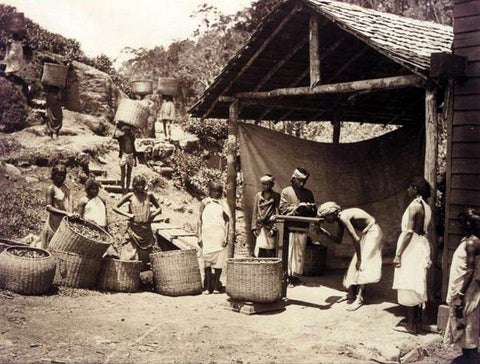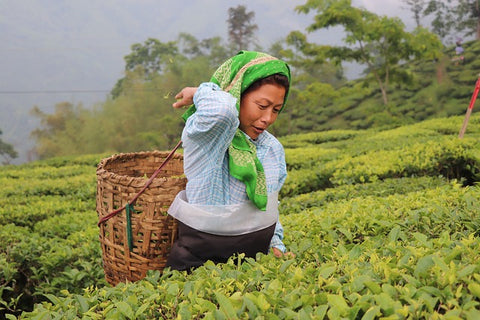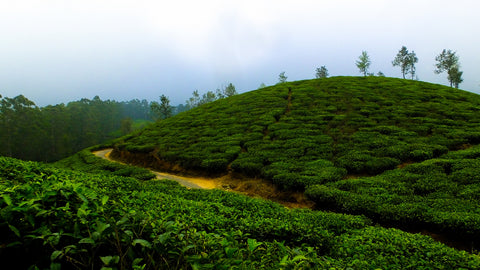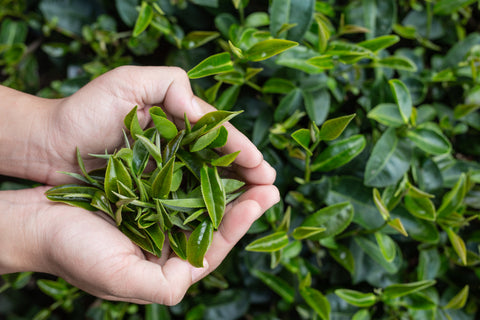What Is Special About Tea From Darjeeling?
Demystifying Darjeeling: What Is Magical About Tea From The Land Of Thunderbolt?
Darjeeling, nestled in the Himalayan foothills of Northern West Bengal in India is home to some of the best tea plantations in the world. Surrounded by verdant rhododendrons and pine forests In the lap of the Kanchenjunga, the landscape is a biodiverse melting pot of flora and fauna. The enchanting region is not only renowned for its stunning landscapes but tea from Darjeeling is also also what sets the region apart. With a perfect combination of altitude, temperature, and soil conditions, Darjeeling has gained a well-deserved reputation for producing some of the world's finest teas. Even today, along with tourism the tea cultivation economy continues to sustain the fragile hills.
So let's explore its history, unique flavor profiles, and why it's a favorite for the enthusiastic tea connoisseur worldwide.
History of Darjeeling Tea: The Jewel in India's Crown

In the 17th century, British colonial enterprise under the East India Company was at its zenith. The oriental jewel that was growing in the high mountains of China had charmed every English. After searching high and wide in places like Assam and Cherrapunji for a suitable place to grow tea in India, the British had a moment of “eureka” on the misty slopes of the Eastern Himalayan corner called Darjeeling. In 1841, Archibald Campbell started experimenting with tea saplings in his garden at Beechwood.
After successfully growing a batch, the Darjeeling tea industry gradually took off with the first tea plantations of the region Tukvar Tea Estate as early as 1856. Happy Valley Tea Estate, Castleton, Makaibari followed soon after. Today there are 89 tea gardens in Darjeeling producing excellent varieties year after year through the meticulous labour of the thousands employed at these estates for generations to produce the “Champagne of Teas.”
What is so special about Darjeeling tea? Darjeeling Tea is Special because of It's Intensive Nurturing

What truly makes Darjeeling tea magical is its complex and diverse flavor profile. Darjeeling tea's flavor profiles can be as diverse as the seasons themselves. The tea bushes require intense nurturing throughout the year. Unlike the ctc variety, these whole leaf teas depend wholly on human effort for their intricate plucking. You can expect hints of muscat grapes, citrusy notes, floral undertones, and a refreshing astringency in every sip. The flavor tea from Darjeeling is a true reflection of its unique terroir and the hard work of the tea workers.
Also Read: Know Darjeeling Blue Tea: Origins, Brewing Secrets & Health Benefits
Now What Does Darjeeling Mean?
The winds of the Himalayas give Darjeeling tea the unique aroma it is famous for. The name comes from the town of Darjeeling on the foothills of the Himalayas in West Bengal, India. The most widely accepted explanation about the etymology of “Darjeeling” is attributed to the Tibetan words “Dorji” which means thunder and “Ling” which means land of abode, So Darjeeling means the “Land of the thunderbolt”. The aboriginal Lepcha origing of the name is “Dar Zyu Lyang” which means the 'abode of the heavenly goddess of beauty'. A third explanation of the name comes from Kirati sources of Khabuwan which state that Darjeeling is derived from “Duwalung” or” the stony place for offering worship.
Tea from Darjeeling Benefits from Its Unique Terroir

Darjeeling's unique combination of geography, altitude, and climate creates the perfect environment for tea cultivation. Here's what makes the terroir of Darjeeling so remarkable:
1. High Altitude: The tea gardens in Darjeeling are situated at high-mountain elevations ranging from 2,000 to 7,000 feet above sea level. This high altitude, combined with cool temperatures, results in slower tea leaf growth and, in turn, more flavorful and complex teas.
2. Mild Climate: Darjeeling experiences distinct seasons, with rainfall in the summer and cooler, dry winters. These variations in weather contribute to the diverse flavor profiles of Darjeeling teas, with each harvest offering something unique.
3. Mineral-rich soil: Tea from Darjeeling benefits from the region's mineral-rich soil, fed by mountain streams, and imparts a distinct character to Darjeeling tea. It's a flavor you won't find anywhere else in the world.
What type of tea is produced in Darjeeling? About Darjeeling Tea Leaves

Darjeeling tea leaves are a variety of the tea plant Camellia sinensis. They are thin leaves, typically with a light color, unique flavor, and a distinct floral aroma. These qualities are a few key reasons why tea from darjeeling is so popular. The key tea varieties grown in Darjeeling include China, Assam, and clonal tea bushes. The different flushes of Darjeeling tea leaves yield different results in color, flavor profile, and aroma. The unique astringency of Darjeeling tea is derived from unoxidized polyphenols such as theaflavins.
Types of Darjeeling Tea

| TYPE | PROCESS | FLAVOR |
| BLACK TEA | Fully oxidized |
|
| WHITE TEA | Unoxidized and least processed |
Finely plucked buds from the highest hills are gently rolled and dried to hold the light-bodied gait of delicate floral aroma and sweet vanilla flavors akin to the terroir of the Himalayas.
This specialty tea is made from the young leaves and buds of the tea plant. It offers a delicate, mild flavor with a naturally sweet profile. |
| GREEN TEA | Unoxidized and Steamed |
A jade liquor that emanates a light-bodied floral grace while holding onto intrinsic herby flavors of green tea. The crisp texture of green tea leaves involves gentle steaming of freshly plucked tea leaves and immediate firing to preserve volatile polyphenols that make the Darjeeling green tea sublimely aromatic and flavorsome. |
| OOLONG TEA | Semi-oxidized |
Each oolong tea is unique to its maker. While the smoky woodiness of a typical oolong is prominent in some, others are ample-bodied with refined floral nuances. Most Darjeeling oolong teas consist of a wholesome body with mild musky flavors of mangoes and a rounded honey finish. |
Harvest Seasons and Varieties: Which tea is famous in Darjeeling?
Darjeeling loose-leaf tea is harvested throughout the year, with each season producing its unique variety:
1. First Flush or Spring Flush

First Flush Darjeeling is harvested in spring, usually from late February to early April. The leaves are delicate and tender, resulting in a light, floral, and often grassy flavor. This tea is celebrated for its delicate and floral notes, often described as bright, brisk, and lively.
2. Second Flush Muscatel Darjeeling Tea

Collected during late spring to early summer, from May to June. summer yields the robust and muscatel-flavored Second Flush Darjeeling, with a more mature taste. It's characterized by muscatel notes, a hint of spiciness, and a rich amber hue. This flush is known for producing a tea with a more robust, full-bodied flavor and a pronounced muscatel note.
FIND OUR MORE: What is Darjeeling Muscatel Tea?
3. Monsoon Flush
This is harvested during the rainy season from July to September. The leaves are larger and produce a milder, less nuanced tea.
3. Autumn Flush
Collected in October and November, the autumn flush offers a unique and complex character with a mix of fruity and woody notes. The later flushes offer full-bodied, fruity, and earthy flavors, each with its charm. Autumn Flush: As the name suggests, this harvest occurs in the autumn months. It features a mellow, full-bodied flavor with fruity undertones.
The Art and Science of Processing Darjeeling Tea
Tea of Darjeeling is processed by the time-honored orthodox method. So unlike, the CTC process, this traditional mechanism preserves the two leaves and a bud with their delicate flavor. The harvesting of Darjeeling tea is an art in itself, meticulously carried out by the labor of the many women tea workers dedicating their hard work to the plucking of tea leaves. After that, the tea undergoes the following:
- Withering: After plucking, the freshly picked tea leaves are spread out on large trays or withering racks. They are allowed to wither, losing moisture and becoming pliable. This process takes around 14-18 hours, depending on the flush.
- Rolling: The withered leaves are then rolled to break their cell walls. This releases the essential oils and initiates fermentation. The rolling can be done manually or mechanically, depending on the estate's practices.

- Fermentation: After rolling, the leaves are spread out in a cool, humid environment to undergo natural oxidation or fermentation. The duration of fermentation varies according to the desired flush, typically ranging from 30 minutes to 4 hours.
- Drying: To halt the oxidation process, the tea leaves are dried in a high-temperature chamber. This removes any remaining moisture and sets the tea's final flavor profile. The drying process is crucial in preserving the unique aroma and flavor of Darjeeling tea.
- Sorting and Grading: The dried tea leaves are sorted into various grades based on their size and appearance. The prized "tippy" teas containa high proportion of buds and are considered the finest.
- Packaging: The final Darjeeling tea is packed in airtight containers to preserve its freshness and unique character. The tea is then ready for distribution and consumption.
So Why is Darjeeling tea so expensive?

The production of Darjeeling tea is a labor-intensive process, where every step plays a crucial role in shaping the final flavor and aroma. The region's unique terroir, high-altitude cultivation, and time-tested techniques combine to produce a tea that is celebrated globally for its refined taste and unmatched quality. The stringent regulations governing Darjeeling tea ensure that it maintains its premium quality and price. Throughout the 20th century Darjeeling tea gardens were dealing with the aftermath of heavy industrialization and toxicity of artificial fertilizers. The owner of a famous tea garden in Darjeeling, Sri Raja Banerjee of Makaibari came back to overhaul the operations of his family’s estate plantations, introducing holistic processes such as full-moon tea picking and biodynamic agriculture. The trend quickly caught on, adding to the value of the already coveted tea from Darjeeling. Provisions of the GI Tag and other such certifications add to tea from Darjeeling being a high-value and prized beverage.
What is Biodynamic Farming? The Myth of Full Moon Tea Picking
Biodynamic agriculture is a pseudo-scientific concept loosely based on esoteric concepts developed by Rudolf Steiner. One of the first organic farming movements that treated soil fertility, plant growth, and livestock as interrelated, with emphasis on spiritual and mystical perspectives. Practitioners believe that If tea is plucked during a full moon, the best orthodox tea manifests, thanks to the optimum cosmic energies, by use of an astrological sowing and planting calendar along with natural manures and composts. It was a strategy developed by the efforts of converting tea estates to organic and overturning the decades of heavy chemical treatment of tea bushes. One of the first teas produced by this process is the Silver Tips Imperial, the best tea from Darjeeling consumed by royal families of England, Japan, Bhutan, etc.
Enjoy a Full Moon Tea Tasting At Mayukh
If you ever find yourself in Darjeeling, escape the crowd and slip into a cosy corner right in the heart of Darjeeling town at Mayukh tea room. Indulge in a full-fledged tea tasting session of the best teas from Darjeeling and understand the it's rich history and culture.
Buy Darjeeling Tea Online
In the world of tea, Darjeeling stands as a beacon of elegance and refinement. Whether you're a seasoned tea aficionado or a beginner looking to explore new flavors, Darjeeling tea is a journey worth embarking on. Its unmatched quality, captivating flavors, and cultural significance make it a true gem in the world of tea. Shop tea from Darjeeling online from our website!






